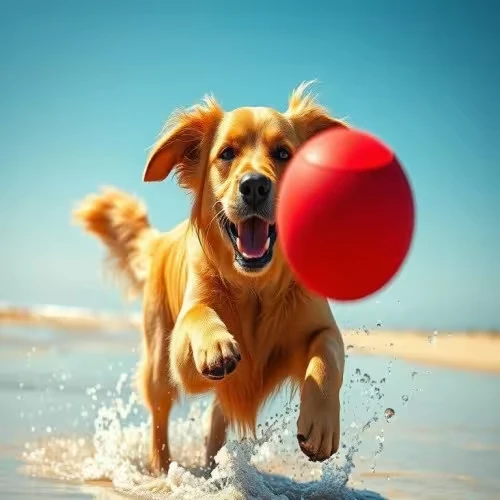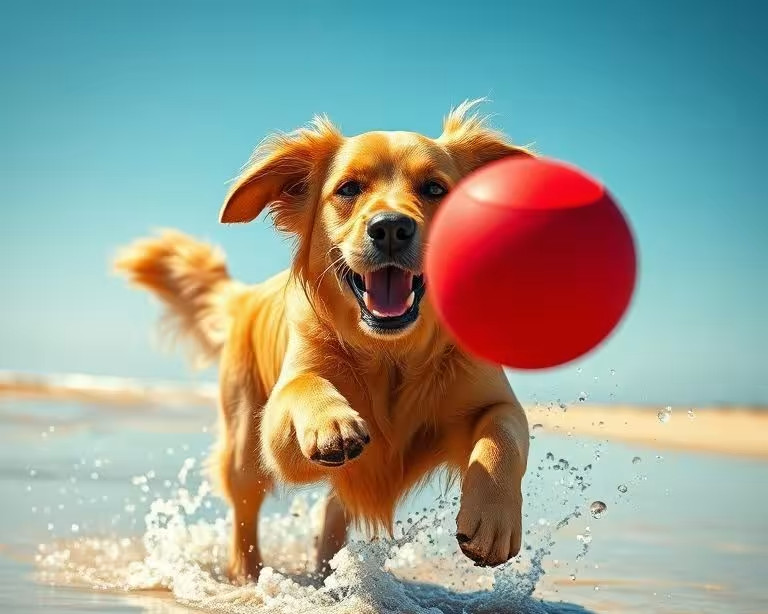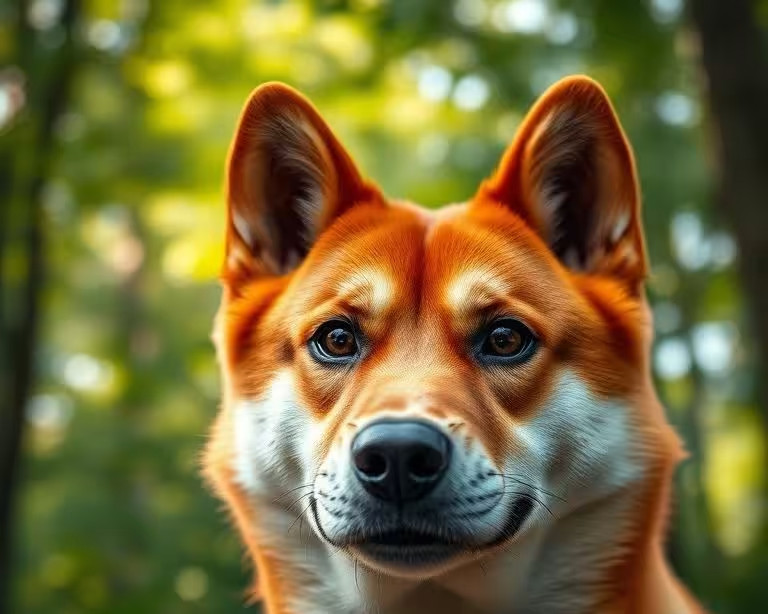The Comprehensive Guide to Red in the World of Dogs: Unveiling Its Multifaceted Significance for E-E-A-T

The color red is ubiquitous, evoking a spectrum of emotions and associations. In the intricate world of our canine companions, 'red' transcends a simple hue, holding profound significance across various aspects of their lives. From the vibrant allure of a favorite toy that sparks endless joy, to the critical warning signs of a potential health issue, and even the nutritional components of their diet, understanding the multifaceted relationship between dogs and the color red is paramount for responsible pet ownership. This in-depth guide, crafted with an E-E-A-T (Expertise, Experience, Authoritativeness, Trustworthiness) focus, delves into every shade of red relevant to dogs, providing actionable insights and data-driven analysis to enhance your furry friend's well-being.
The Allure of Red Dog Toys: More Than Just a Plaything
For many dogs, a red toy isn't just an object; it's an invitation to adventure, a source of boundless energy, and a tool for mental and physical stimulation. The visual appeal of red plays a significant role, often standing out against various backdrops, making it easily distinguishable for a dog's dichromatic vision. Beyond mere visibility, the tactile experience these toys offer is equally important.
Why Dogs Are Drawn to Vibrant Red Toys
While dogs perceive colors differently than humans (primarily seeing blues, yellows, and grays), a bright red object can still be highly stimulating. It often contrasts strongly with green grass or brown indoor environments, making it easy for dogs to spot during a game of fetch or hide-and-seek. The intensity of a red toy can capture a dog's attention, triggering their natural prey drive and encouraging engagement. Manufacturers strategically use red to create toys that are not only visually appealing to pet owners but also highly engaging for dogs, promoting activity and reducing boredom.
Beyond color, the design and texture of red toys are crucial. A squeaky red ball can provide auditory feedback that excites a dog, while a durable red chew toy satisfies their innate urge to gnaw, promoting dental health and preventing destructive chewing on household items. The variety in red toy offerings ensures that there's a perfect match for every dog's play style and chewing intensity.

The Importance of Choosing Safe Red Dog Toys
While the excitement of a new red toy is undeniable, safety must always be the top priority. The market is flooded with options, but not all are created equal. When selecting red toys, consider the following critical factors:
- Material Safety: Ensure toys are made from non-toxic, pet-safe materials. Look for certifications from reputable organizations. Avoid toys with excessive dyes that could leach, although most reputable brands use pet-safe colorants.
- Durability: Match the toy's durability to your dog's chewing habits. A strong chewer needs robust rubber or nylon, while a gentle player might enjoy plush toys. Regularly inspect toys for wear and tear, as damaged toys can pose choking hazards or lead to ingestion of foreign objects.
- Size Appropriateness: The toy should be large enough that it cannot be swallowed whole or become lodged in your dog's throat. Conversely, it shouldn't be so large that your dog cannot comfortably interact with it.
- Small Parts: Avoid toys with small, detachable components (e.g., plastic eyes, bells) that could be chewed off and ingested.
Supervision during playtime, especially with new toys, is always recommended to ensure your dog's safety.
Comparing Popular Red Toy Materials: Durability & Safety
Understanding the properties of different materials used in red dog toys can help owners make informed decisions:
- Natural Rubber: Highly durable, flexible, and often non-toxic. Excellent for strong chewers. Pros: Long-lasting, good bounce for fetch, easy to clean. Cons: Can be heavy, some dogs may not prefer the texture.
- Synthetic Rubber (e.g., TPR - Thermoplastic Rubber): Offers a range of densities and textures, often used for squeaky toys or those with unique shapes. Pros: Versatile, can be very durable, often floats. Cons: Quality varies greatly by brand; always check for non-toxic claims.
- Nylon: Extremely tough and designed for aggressive chewers. Often comes in bone or stick shapes. Pros: Nearly indestructible for most dogs, helps clean teeth. Cons: Can be very hard, potentially causing dental wear if chewed excessively; not all dogs find them appealing.
- Plush/Fabric: Soft, comforting, and great for gentle play or cuddling. Often come in a variety of red shades. Pros: Lightweight, good for indoor play, comforting. Cons: Easily torn apart by chewers, stuffing can be ingested, requiring frequent replacement.
By considering these material properties in conjunction with your dog's play style, you can select red toys that offer both enjoyment and safety.
Red as a Critical Indicator in Canine Health
While red signifies excitement in play, its appearance in a dog's health can be a critical signal for underlying issues. As vigilant pet owners, recognizing these 'red flags' is crucial for early intervention and maintaining your dog's well-being.
Identifying Common Red Flags on Your Dog's Skin and Gums
Regularly checking your dog's skin, eyes, and gums can help you spot issues early:
- Skin Redness/Rashes: Localized redness, especially accompanied by itching, bumps, or hair loss, can indicate allergies (environmental, food, or flea), hot spots (acute moist dermatitis), bacterial or fungal infections (like ringworm), or parasitic infestations. Pay close attention to paws, armpits, and groin areas.
- Red Eyes: A dog's eyes should be clear. Redness in the whites of the eyes (sclera) or inflammation of the eyelids can point to conjunctivitis (pink eye), allergies, dry eye syndrome, corneal ulcers, glaucoma, or the presence of a foreign body. Any discharge accompanying the redness warrants immediate attention.
- Red Gums: Healthy gums are typically a bubblegum pink. Bright red, swollen, or bleeding gums are classic signs of gingivitis or more advanced periodontal disease, which can lead to tooth loss and systemic health problems. Dark red or purple gums can indicate a more severe issue like heatstroke or shock.
- Red Urine or Stool: Blood in urine (hematuria) can appear red or pink and may signal a urinary tract infection, bladder stones, kidney disease, or even certain cancers. Blood in stool can range from bright red streaks (hematochezia, indicating lower digestive tract bleeding) to dark, tarry stool (melena, indicating upper digestive tract bleeding). Both require prompt veterinary investigation.
Observing these changes, even subtle ones, is the first step toward addressing potential health concerns.
When Red Signals Urgent Veterinary Care
Some manifestations of redness demand immediate professional attention. These symptoms could indicate life-threatening conditions:
- Profuse Bleeding: Any significant external or internal bleeding that is not easily controlled, whether from a wound, nosebleed, or orifices.
- Severe Redness with Swelling: Particularly around the face, neck, or mouth, which could indicate a severe allergic reaction (anaphylaxis) or an abscess.
- Dark Red/Purple Gums: As mentioned, this can be a sign of shock, severe dehydration, heatstroke, or carbon monoxide poisoning – all medical emergencies.
- Difficulty Breathing: If redness is accompanied by labored breathing, coughing, or gasping, it's an emergency.
- Redness with Signs of Pain/Distress: Whining, lethargy, loss of appetite, vomiting, or diarrhea alongside significant redness, especially in the abdominal area, could indicate internal injury or organ failure.
In these scenarios, time is of the essence. Contact your veterinarian or an emergency animal hospital immediately.
Proactive Monitoring: Early Detection of Red Symptoms
The best defense against serious health issues is proactive monitoring. Integrate these practices into your routine:
- Daily Visual Checks: A quick glance at your dog's eyes, nose, and mouth daily can catch early signs.
- Weekly Body Checks: During grooming or petting, run your hands over their entire body, checking for bumps, rashes, or tender spots. Lift their lips to inspect gums and teeth.
- Observe Behavior: Any changes in appetite, water intake, energy levels, elimination habits, or overall demeanor can be subtle indicators of internal distress.
- Regular Vet Check-ups: Annual or semi-annual veterinary visits are crucial for professional assessments, vaccinations, and parasite prevention, often catching issues before they become visible to owners.
Your attentiveness is a powerful tool in ensuring your dog's long-term health and happiness.
Enhancing Safety and Style with Red Collars and Harnesses
Red collars and harnesses are a popular choice among dog owners, offering a compelling blend of practicality and aesthetic appeal. Beyond just fashion, the vibrant nature of red plays a vital role in canine safety and identification.
The Visibility Advantage: Why Red Stands Out
One of the primary benefits of a red collar or harness is enhanced visibility. The bright, bold color makes your dog more noticeable, particularly in situations where they might otherwise blend into the environment. This is especially critical during:
- Low-Light Conditions: At dusk, dawn, or during nighttime walks, a red collar, especially one with reflective elements, can significantly increase your dog's visibility to motorists, cyclists, and pedestrians.
- Dense Foliage: If your dog loves to explore wooded areas or tall grass, a red harness can make them easier to spot, reducing the risk of getting lost.
- Crowded Areas: In busy parks or urban settings, a distinct red accessory helps you keep track of your dog amidst other people and pets.
Many red collars and harnesses are designed with additional safety features such as reflective stitching, LED lights, and bright, contrasting patterns to maximize their visibility, making walks safer for both you and your canine companion.

Ensuring the Perfect Fit for Your Dog's Red Gear
A stylish red collar or harness is only effective if it fits correctly. An ill-fitting piece of gear can lead to discomfort, chafing, or even escape. Follow these guidelines for a proper fit:
- Collar Fit (The Two-Finger Rule): For collars, you should be able to comfortably slide two fingers between the collar and your dog's neck. It should be snug enough not to slip over their head, but not so tight that it restricts breathing or causes irritation.
- Harness Measurement: Measure your dog's chest girth (the widest part of their rib cage, just behind the front legs) and neck circumference. Compare these measurements to the manufacturer's sizing chart.
- Adjustability: Opt for collars and harnesses with adjustable straps to achieve a custom fit, especially for growing puppies or dogs with unique body shapes.
- Material Comfort: Consider the material. Padded or soft-lined red harnesses can prevent chafing, especially for dogs with sensitive skin or short coats.
Regularly check the fit as your dog's weight or coat thickness may change seasonally.
Innovative Features in Modern Red Collars and Harnesses
Modern red dog gear often incorporates advanced features for enhanced safety, comfort, and functionality:
- Reflective Stitching/Strips: Essential for nighttime visibility, reflecting light from vehicle headlights.
- LED Illumination: Battery-powered lights or light-up strips provide active illumination, making your dog visible from a greater distance in the dark.
- GPS Trackers: Some red collars integrate small GPS devices, offering peace of mind by allowing you to track your dog's location if they wander off.
- No-Pull Designs: Front-clip harnesses, often available in red, discourage pulling by redirecting your dog's attention back towards you.
- Quick-Release Buckles: For safety in emergencies, allowing for rapid removal of the collar or harness.
- Ergonomic Padding: Breathable mesh or soft neoprene padding reduces pressure points and increases comfort, especially important for longer walks or active dogs.
When selecting red gear, consider these features to find the best option for your dog's specific needs and your lifestyle.
Navigating Red in Your Dog's Diet: Nutrients and Risks
The color red also appears prominently in discussions about canine nutrition, from essential protein sources to certain fruits and vegetables. Understanding what red foods are beneficial and which should be avoided is key to a balanced and healthy diet.
Beneficial Red Ingredients in Dog Food: A Nutritional Breakdown
Many high-quality dog foods feature red-colored ingredients that are packed with essential nutrients. Here's a look at some common and beneficial options:
- Red Meats (Beef, Lamb, Venison, Bison): These are excellent sources of protein, crucial for muscle development, tissue repair, and overall energy. They are also rich in vital minerals like iron (for healthy blood), zinc (for immune function), and B vitamins (for metabolism). For example, a typical high-quality dog food with beef as a primary ingredient might contain: Protein: 25-30%, Fat: 15-20%, Fiber: 3-5%. Lamb is often considered a novel protein for dogs with sensitivities, offering similar nutritional benefits with a slightly different fatty acid profile. Venison and bison are lean red meats, providing high protein with lower fat content, ideal for weight management or sensitive stomachs.
- Cranberries: These small red berries are well-known for their urinary tract health benefits, helping to prevent bacterial adhesion. They are also rich in antioxidants and Vitamin C.
- Raspberries & Strawberries: In moderation, these red fruits offer antioxidants, fiber, and vitamins. Always ensure they are served plain and in small quantities due to their sugar content.
- Beets: These vibrant red root vegetables are a good source of fiber, Vitamin C, potassium, and manganese. They can aid in digestion and contribute to a healthy coat.
When choosing dog food, look for formulations where real red meat is listed as the first ingredient, indicating a high-quality protein source. Always check the guaranteed analysis for specific nutrient percentages.
Red Foods to Avoid: Understanding Potential Hazards
Not all red foods are safe for dogs. Some can be toxic or cause digestive upset:
- Processed Red Meats: Human-grade processed meats like pepperoni, hot dogs, and bacon are often high in sodium, unhealthy fats, and preservatives, which can be detrimental to a dog's health, leading to pancreatitis or obesity.
- Artificial Red Dyes: Some low-quality dog treats or foods use artificial red dyes to make them visually appealing to owners. These dyes offer no nutritional value and some studies suggest potential links to hyperactivity or allergic reactions in sensitive dogs. Prioritize natural ingredients.
- Rhubarb: The leaves and stalks of rhubarb are toxic to dogs due to oxalic acid, which can cause kidney problems.
- Cherries: The pits, stems, and leaves of cherries contain cyanide and are toxic. The fruit itself can be given in very small, pitted quantities, but it's generally safer to avoid.
- Spicy Red Peppers: Chili peppers and other spicy foods can cause severe gastrointestinal distress in dogs, including vomiting, diarrhea, and abdominal pain.
Always err on the side of caution and research any human food before offering it to your dog.
The Essential Role of Veterinary Consultation for Red-Colored Foods
Before making any significant changes to your dog's diet, especially when introducing new red-colored foods or supplements, it is crucial to consult your veterinarian. They can provide personalized advice based on your dog's:
- Breed and Age: Nutritional needs vary significantly across different breeds and life stages (puppy, adult, senior).
- Activity Level: Highly active dogs require more calories and specific nutrient balances.
- Existing Health Conditions: Dogs with allergies, kidney disease, diabetes, or other conditions require specialized diets. Your vet can advise on suitable red meat proteins or fruits/vegetables that won't exacerbate their condition.
- Medications: Some foods can interact with medications, so always inform your vet about your dog's full diet.
Your vet can help you formulate a balanced diet, recommend appropriate portion sizes, and identify any red-colored ingredients that might cause adverse reactions, ensuring your dog receives optimal nutrition tailored to their unique needs.
Red in Canine Culture: Art, Photography, and Symbolism
Beyond the practical aspects of health and safety, the color red holds a significant place in the artistic and cultural representation of dogs. It's a color that can evoke strong emotions and highlight specific characteristics, making it a powerful tool for creators.
Capturing Canine Spirit: Red's Impact in Dog Art
Artists frequently utilize red to infuse their canine subjects with vitality, warmth, and a sense of presence. Whether depicting a majestic Red Setter in a field or a playful terrier with a striking red collar, the color can:
- Draw Attention: A splash of red can immediately draw the viewer's eye to the dog, emphasizing its central role in the artwork.
- Convey Energy and Movement: Red is dynamically associated with action. An artist might use red brushstrokes to suggest the blur of a dog in motion or the intensity of its focus.
- Highlight Features: Red can be used to accentuate specific elements, such as the vibrant hue of a dog's fur (like a Shiba Inu or Irish Setter) or a beloved red accessory, making them pop against a more subdued background.
From classical paintings to contemporary illustrations, red helps artists capture the unique spirit and personality of dogs in compelling ways.

The Emotional Resonance of Red in Dog Photography
Photographers leverage red to create impactful and emotionally charged images of dogs. The color can be used strategically to:
- Create Contrast: A bright red object (like a ball or bandana) against a natural, muted background can make the dog and its interaction with the object stand out dramatically.
- Evoke Warmth and Comfort: Soft, warm reds can be used in blankets or backdrops to create a cozy, inviting atmosphere around a sleeping or resting dog.
- Add Drama: In more stylized or moody photography, deep reds can contribute to a sense of power, mystery, or intensity, especially when paired with breeds known for their strong presence, like Dobermans or Rottweilers.
The strategic use of red in photography allows for the creation of visually stunning and emotionally resonant portraits that celebrate the bond between humans and dogs.
Decoding the Symbolism of Red: Passion, Energy, and Loyalty
In many cultures, red carries rich symbolic meanings that naturally extend to our perception of dogs. When applied to canines, red often symbolizes:
- Passion and Love: The deep, unconditional love and companionship dogs offer are often associated with the warmth and passion of red.
- Energy and Vitality: The boundless energy of a playful puppy or the unwavering drive of a working dog aligns perfectly with red's association with life force and dynamism.
- Loyalty and Courage: The protective instinct and unwavering loyalty of many dog breeds can be symbolized by red, representing strength and bravery.
This symbolic depth adds another layer to our appreciation of dogs, making red a fitting color to represent their multifaceted roles in our lives.
Frequently Asked Questions (FAQ) About Red and Dogs
Q1: Can dogs actually see the color red?
A: Dogs are dichromats, meaning they have two types of cone cells in their eyes, unlike humans who are trichromats with three. This means dogs primarily see in shades of blue, yellow, and gray. They cannot distinguish between red and green; red objects often appear as a shade of dark yellow or brown to them. However, the brightness and contrast of a red object against its background can still make it highly visible and stimulating.
Q2: Are red dog collars safer than other colors?
A: Red collars can offer a visibility advantage, especially when paired with reflective materials, making your dog more noticeable in low-light conditions or against natural backdrops. While the color itself doesn't guarantee safety, its high contrast can contribute to accident prevention. The material, fit, and additional features (like reflective strips or LED lights) are equally, if not more, important for safety than the color alone.
Q3: What does it mean if my dog's skin or gums are red?
A: Red skin can indicate allergies, infections (bacterial, fungal), parasites, or hot spots. Red gums are often a sign of gingivitis or periodontal disease. In more severe cases, dark red or purple gums can signal a medical emergency like heatstroke or shock. Any persistent redness should be evaluated by a veterinarian to determine the underlying cause and appropriate treatment.
Q4: Are all red dog foods healthy for my pet?
A: Not necessarily. While many quality dog foods contain beneficial red ingredients like red meats (beef, lamb) and certain fruits/vegetables (cranberries, beets), some lower-quality foods or treats may use artificial red dyes, which offer no nutritional value and could potentially cause sensitivities. Always check the ingredient list and prioritize natural, whole-food sources. Consult your vet before making significant dietary changes.
Q5: My dog loves red toys. Is there a psychological reason for this?
A: While dogs don't see red as we do, the vibrancy and contrast of red toys make them visually engaging. The shape, texture, and sound (like squeakers) of a red toy are often more significant factors in a dog's preference than the color itself. Many red toys are designed to be highly stimulating and durable, making them popular choices for energetic play.
Q6: Can feeding my dog red fruits like strawberries or raspberries be harmful?
A: In moderation, plain, fresh strawberries and raspberries are generally safe and can offer antioxidants and vitamins. However, they contain natural sugars, so they should be given as occasional treats and in small quantities. Always remove stems and leaves, and avoid any processed or sweetened versions of these fruits. Large quantities can cause digestive upset. Consult your vet, especially if your dog has diabetes or other health conditions.
Conclusion: Embracing the Spectrum of Red for Your Canine Companion
The color red, in its myriad forms, plays a surprisingly profound and diverse role in the world of dogs. From igniting the spark of playful joy with a favorite toy to serving as a critical alert in canine health, guiding safety during walks, and enriching their diet with vital nutrients, red is a color of significant impact. As responsible and attentive dog owners, our understanding of these multifaceted associations allows us to make more informed decisions.
By prioritizing the safety and engagement offered by well-chosen red toys, vigilantly monitoring for 'red flags' in health, selecting red collars and harnesses that enhance safety and comfort, and making educated choices about red-colored foods in their diet, we can significantly contribute to our dogs' overall well-being. Embracing the spectrum of red in your dog's life means embracing a deeper level of care, awareness, and commitment, ensuring they lead a life that is as vibrant and fulfilling as the color itself.

 By
By
No comments yet. Be the first!